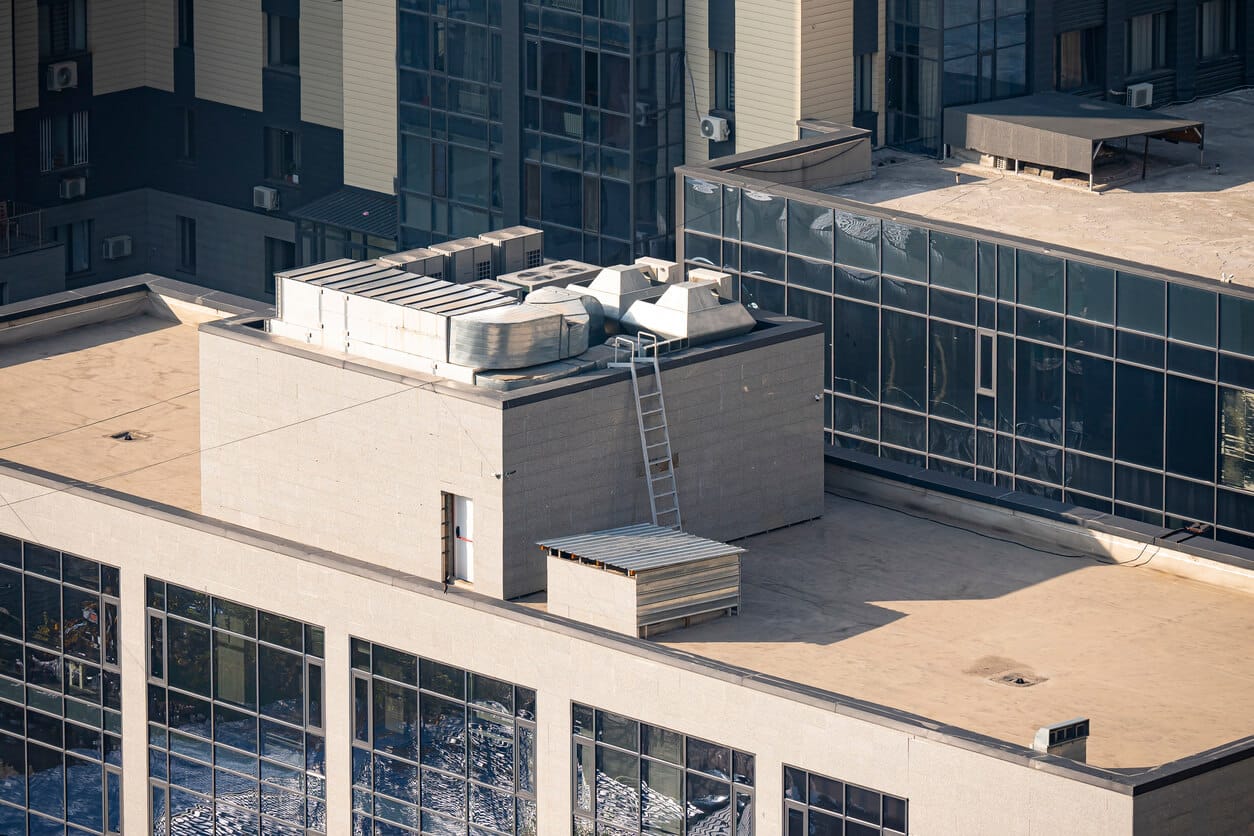
The storm hit hard last night. You heard the wind battering the roof, saw the rain pouring sideways, and hoped, like always, that your home would hold.
But this morning, something feels off. A soft spot on the ceiling. A dripping sound near the wall. Maybe it’s nothing. Or maybe it’s the start of something costly.
If you own a home with a flat roof, you know how tricky things can get. A tiny breach in the membrane, a loose flashing edge, or a clogged drain can quietly lead to thousands in damage. And when you call most roofing companies, they’ll tell you the same thing: “It’s time for a full replacement.”
But what if it’s not?
At Mr. Roofer, we do things differently. With decades of hands-on experience in Atlanta’s volatile weather, we know that most flat roof issues can be solved with smart, targeted repairs, not high-pressure sales tactics. We believe in giving homeowners options, clarity, and peace of mind.
In this guide, we’ll walk you through how flat roofs really work, the signs of damage to watch for, and how to protect your home without overpaying or overreacting.
How Flat Roofs Work and Why They Leak
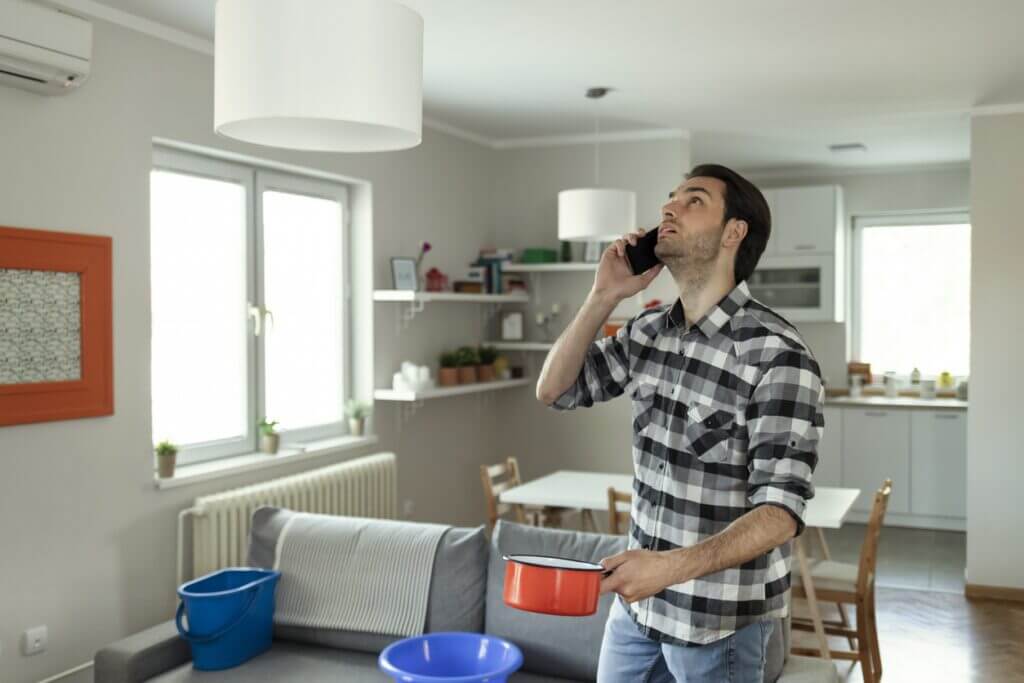
Flat roofs may appear simple, but they’re complex systems engineered to manage water, protect your home, and support HVAC equipment or outdoor spaces. When even one component fails, leaks often follow, causing damage far beyond the roof itself.
Anatomy of a Flat Roof
Understanding the structure of a flat roof helps explain how leaks develop. Here’s a breakdown of its key components:
Membranes
Flat roofs rely on waterproof membranes like TPO, EPDM, or modified bitumen to repel water. These roofing materials are durable but not invincible. They can blister, crack, shrink, or split with time and temperature shifts. Poor installation or seam failure is a common culprit behind leaks.
Flashing
Flashing bridges the vulnerable gaps between the membrane and roof features like chimneys, walls, and skylights. When improperly installed or corroded by the elements, roof flashing becomes a gateway for water intrusion, especially during heavy rains.
Drainage Points
Unlike pitched roofs, flat systems depend on internal drains, scuppers, or gutters to shed water efficiently. When these are clogged with debris or poorly sloped, water pools, leading to membrane breakdown and leaks.
Common Vulnerabilities
Flat roofs often feature equipment or structures that compromise their watertight integrity. Here are some of the most leak-prone zones:
Pipe Penetrations and Vents
Plumbing stacks, exhaust vents, and other protrusions require tight seals with boot flashing. Over time, these seals crack or separate due to movement and UV exposure, inviting water inside.
Chimney Flashing on Flat Roofs
Chimneys on flat roofs demand meticulous flashing work, especially at the corners where water tends to collect. Improper step or counter-flashing can lead to persistent leaks at the base of the chimney, often mistaken for masonry issues.
HVAC Curb Leaks
Many flat roofs support HVAC units on raised curbs. If those curbs aren’t sealed correctly, or if vibration from equipment wears down the sealant, water can easily seep in and spread through the roof deck.
Weather and Age-Related Issues Specific to the Atlanta Climate
Atlanta’s climate isn’t kind to flat roofs. From high summer temps to volatile storms and mature tree canopies, each season brings unique threats.
High Humidity & Summer Heat
Prolonged heat and moisture strain roofing membranes. Materials expand and contract daily, weakening seams and accelerating wear. Humidity also encourages mold growth and rot under the membrane if leaks go undetected.
Sudden Storms and Flash Flooding
Atlanta’s rapid downpours can overwhelm drainage systems. If water ponds even briefly, it stresses the membrane and exploits minor flaws, turning small issues into leaks overnight.
Freezing and Thawing in Winter
Even in the South, cold snaps pose risks. Water trapped in small cracks or seams freezes and expands, breaking bonds in the roofing layers. Over time, this freeze-thaw cycle causes cumulative damage.
Tree Debris from Mature Landscaping
Affluent neighborhoods often feature large, mature trees. Their branches, leaves, and seed pods can clog drains, scrape membranes, and create shaded areas where water lingers longer, perfect conditions for slow-developing leaks.
UV Degradation
Atlanta’s sun is strong. UV rays dry out membranes, crack sealants, and fade surface coatings. Even reflective materials lose effectiveness over time, accelerating heat-related stress on the roof system.
Aging Building Stock
Many upscale homes in Atlanta were built decades ago. Their flat roof systems may be past their intended lifespan, built to outdated specs, or layered over previous systems, making them more vulnerable to leaks and harder to repair without a full replacement.
Signs You Need Flat Roof Repairs
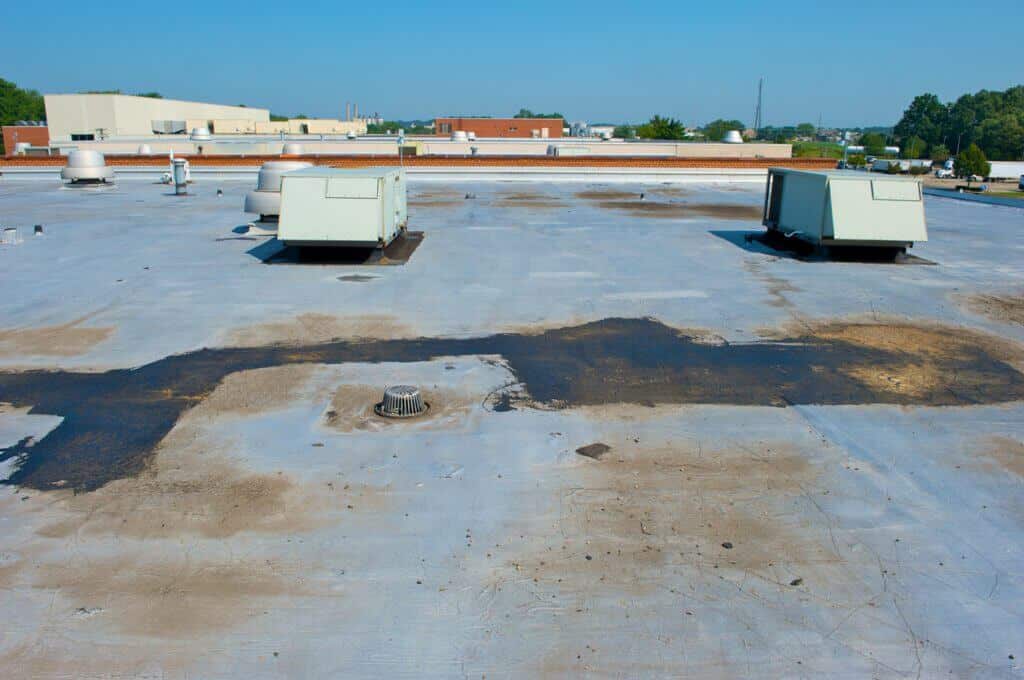
Flat roof problems often start subtly but can escalate quickly if left unchecked. Recognizing the early warning signs, both inside and out, can save thousands in water damage and prevent a minor leak from turning into a full replacement.
Interior Warning Signs
Issues inside your home often signal that your roof’s protective layer has already been breached. Keep an eye (and nose) out for the following:
Ceiling Stains
Brown, yellow, or rust-colored stains on ceilings or upper walls are often the first visible hint of a roof leak. These stains may grow after a storm or seem to fade during dry spells, but they always point to a persistent problem above.
Musty Smells
A persistent, damp odor in upper rooms, closets, or hallways is often caused by trapped moisture. Even if you can’t see the leak, that musty smell is your home telling you something is wrong, possibly within the insulation or walls.
Mold
When a leak goes unnoticed long enough, mold may start to form inside your drywall or HVAC system. This is not only a structural issue. It’s a health hazard, especially for children, elderly residents, or anyone with allergies.
Exterior Issues
Many flat roof problems are visible from above if you know what to look for. Regular inspections, especially after major storms, can help spot these common issues early:
Ponding Water After 48+ Hours
Flat roofs are designed to drain quickly. If water is still sitting on the surface two days after a storm, it’s a red flag. Persistent ponding stresses the membrane and indicates poor slope or clogged drains: two major contributors to leaks.
Blisters, Cracks, or Bubbling
If you notice raised, bubble-like formations on your roof’s surface, it’s a sign of trapped moisture or gas under the membrane. Cracks and splits can also form from temperature changes or foot traffic. These vulnerabilities lead directly to water intrusion.
Peeling Membrane or Flashing Damage
Look for peeling edges, detached seams, or gaps where flashing meets the wall or curb. These exposed areas are entry points for water, especially during heavy rains or high winds. They usually signal aging materials or poor past flat roof repairs.
Importance of Attic Checks and Thermal Scanning
Don’t stop at surface-level inspections. Your attic holds critical clues about your flat roof’s condition.
Thermal imaging can detect hidden leaks before they show up as visible damage. Moisture trapped under membranes or insulation gives off different heat signatures, which skilled technicians can spot with infrared scanning. These tools help identify soft spots, saturation, and rot early, often before major repairs are needed.
Even a quick visual check of your attic insulation, rafters, and underside of the roof deck can reveal trouble. Dark streaks, damp patches, or signs of wood rot suggest water has already breached your roof’s defenses.
Causes of Flat Roof Leaks in Atlanta Homes
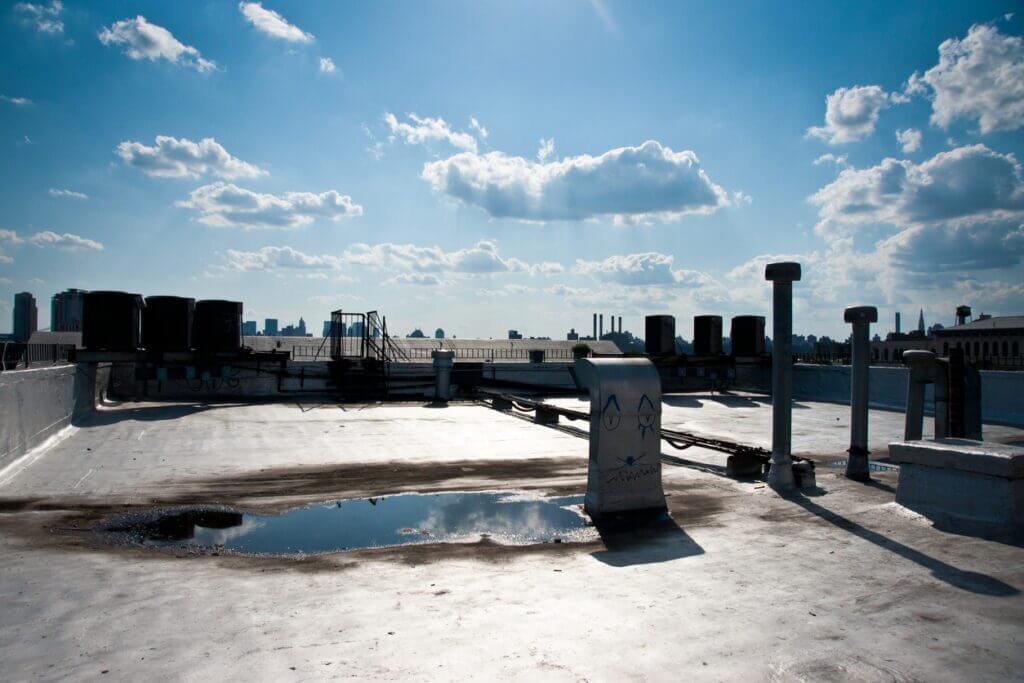
Leaks aren’t just a result of age. They often stem from issues that begin during installation or go unnoticed during routine maintenance. Atlanta’s unique climate and tree-heavy neighborhoods amplify these risks, especially if you live in an older or custom-built home.
Common Causes
Here’s a breakdown of the most frequent culprits behind flat roof leaks in Atlanta homes:
Cause | Description |
Improper Installation | Poorly sealed seams, incorrect slope, or shortcuts taken during original installation can lead to leaks within just a few years, even if the materials themselves are high quality. |
Storm Debris Blocking Drainage | With Atlanta’s frequent storms and mature landscaping, leaves, twigs, and pine needles often clog scuppers, downspouts, and internal drains. Blockages cause water to back up and pond, weakening the membrane over time. |
Poor Maintenance or Aging Materials | Even durable roofing systems break down over time. UV exposure, thermal cycling, and lack of routine inspections can allow minor damage to develop into serious leaks. Regular maintenance is essential, especially in Atlanta’s high-humidity environment. |
Flashing Failure and Delamination Explained
Two of the most insidious sources of leaks, flashing failure and membrane delamination, often go undetected until significant damage is done.
Flashing failure occurs when the metal or membrane used to seal transitions (like where a roof meets a wall or vent) becomes loose, rusted, or unsealed. In Atlanta’s climate, this is often accelerated by high humidity, summer heat, and frequent freeze-thaw cycles that cause expansion and contraction of the materials. When flashing pulls away or corrodes, it creates a direct channel for water intrusion.
Delamination happens when layers of a flat roof membrane begin to separate, usually due to trapped moisture, poor adhesion during installation, or long-term sun damage. Once delamination begins, water can seep in between layers of the roofing system, bypassing surface-level inspections. This issue often mimics flashing or drain problems and is especially common in aging roofs or those subjected to ponding water.
Both of these problems require expert diagnosis and careful, professional repair. They’re rarely visible from the ground, which is why thorough inspections, especially after a major storm or once a year, are critical for homeowners who want to stay ahead of costly damage.
DIY vs. Professional Flat Roofing Repairs
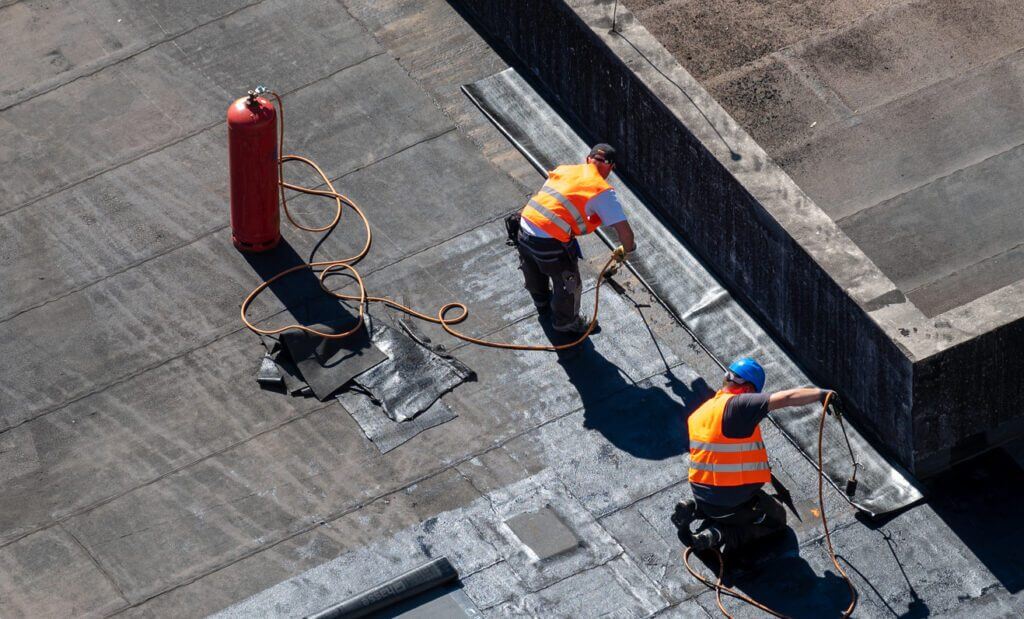
With endless home improvement videos online and patch kits available at every hardware store, it’s tempting to tackle a roof issue yourself. But flat roofs are uniquely deceptive. What looks like a small surface problem is often a symptom of deeper, hidden damage. Here’s how to know where your efforts help and where they can hurt.
What Homeowners Can Safely Inspect or Do
Some preventative tasks and visual checks are perfectly safe and beneficial for vigilant homeowners:
- Visual roof inspections: Use binoculars or a drone (not a ladder) to look for pooling water, debris buildup, or visible damage to flashing and seams.
- Clear drain inlets and gutters: Removing leaves or pine needles after a storm can prevent ponding and overflow.
- Monitor ceiling and attic spaces: Check for stains, musty odors, and signs of mold in upper rooms or attic insulation.
- Document changes over time: Take photos of your roof after major storms and during dry weather to monitor problem areas.
These simple actions can help spot issues early, but they shouldn’t replace professional assessments.
Risks of DIY Patch Kits and Misdiagnosed Leaks
Over-the-counter patch kits or sealants might appear to solve the problem, but they rarely address the root cause. Here’s where DIY fixes can backfire:
- Trapping moisture: Sealing a blister or crack without identifying the source of water intrusion can trap moisture under the membrane, accelerating rot.
- Improper material use: Many kits aren’t compatible with your existing roof membrane (e.g., TPO, EPDM, modified bitumen), leading to adhesion failures.
- Overlooking structural damage: What appears to be a small leak may actually stem from a failed HVAC curb, saturated insulation, or compromised decking, none of which are visible at surface level.
Worst of all, DIY missteps can void manufacturer warranties or insurance claims, making future professional flat roof repairs more expensive.
Why 70% of Mr. Roofer’s Jobs Are Repairs (Not Replacements)
At Mr. Roofer, we lead with integrity, not upselling. That’s why 7 out of 10 jobs we complete are precision repairs, not full roof replacements.
Many roofing contractors lean toward replacements because it’s faster and more profitable, but we believe in solving problems, not just selling projects. Our experienced technicians use advanced diagnostics (like thermal imaging and core sampling) to pinpoint exact leak sources. That means:
- No guesswork or unnecessary tear-offs
- Lower costs and minimized disruption to your home
- Long-term peace of mind with targeted flat roof repairs that extend your roof’s lifespan
In short, the right contractor can save you far more than the “quick fix” patch kit ever will.
Preventing Future Leaks: Maintenance Tips for Flat Roofs
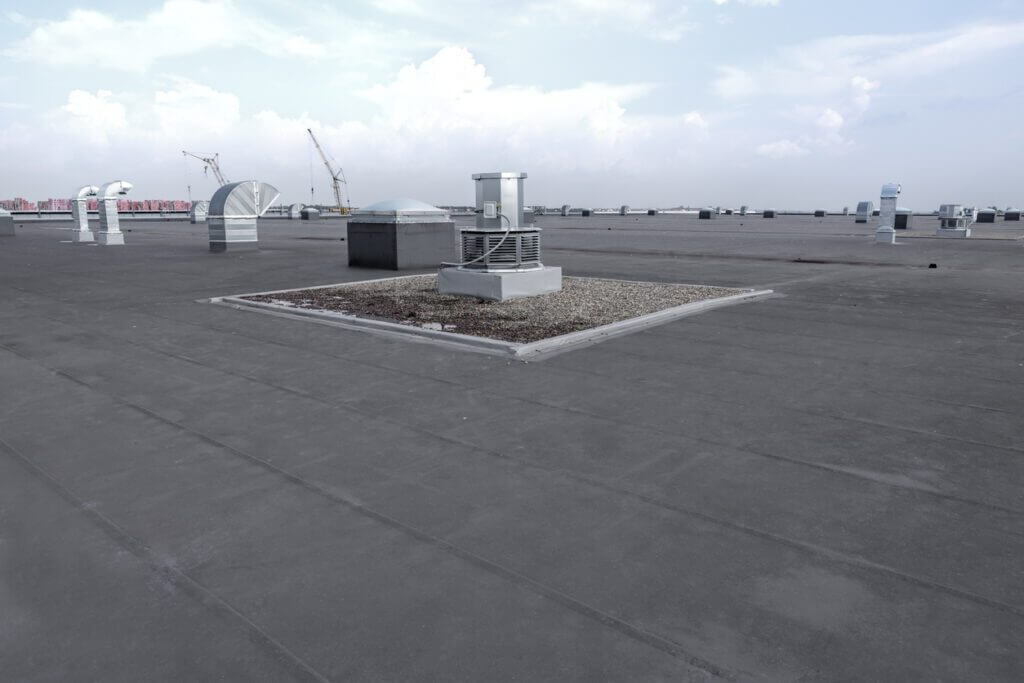
Flat roofs don’t have to be leak-prone. With consistent, proactive maintenance, homeowners can extend roof lifespan by years and avoid surprise flat roof repair bills. Here’s how to keep your flat roof in top shape, especially in Atlanta’s demanding climate.
Annual Inspections and Debris Removal
A once-a-year professional inspection is the single most important maintenance investment you can make. These checks uncover early signs of wear, drainage issues, or material fatigue before they turn into leaks.
Between inspections, homeowners should:
- Clear off leaves, sticks, and debris after every major storm
- Visually check for ponding water after rainfall (especially near drains and low spots)
- Ensure gutters and downspouts flow freely. Clogs cause ponding and structural stress
In Atlanta, where tree debris and sudden storms are constant, quarterly cleanups may be warranted for homes with heavy canopy cover.
Keeping Flashing and Pipe Boots Intact
Your roof’s flashing and pipe boots are small components with a big job: sealing out water where the membrane meets penetrations and vertical surfaces.
To prevent leaks:
- Inspect flashing annually for rust, peeling, or separation from walls or curbs
- Check pipe boots for cracks, dry rot, or loose seals around plumbing vents and HVAC lines
- Re-seal joints with compatible materials if signs of wear appear—don’t wait until water enters
These parts are especially vulnerable to Atlanta’s summer heat and freeze-thaw cycles. A failed boot or loose flashing can let in gallons of water before you ever see a ceiling stain.
Early Detection = Lower Flat Roof Repair Bills
One of the biggest myths in roofing is “out of sight, out of mind.” In reality, small roof problems cost the most, not because they’re expensive to fix, but because they’re often ignored until they become large ones.
Here’s why early detection pays off:
- Repairing a minor seam split might cost a few hundred dollars
- Ignoring that split until water saturates the insulation can lead to thousands in rot repairs
- Thermal imaging or moisture scans during a routine inspection can spot these hidden risks long before symptoms appear inside your home
In short, a little vigilance saves a lot of money and helps keep your flat roof performing at its best.
Final Thoughts: Protect What’s Over Your Head
Your flat roof does more than keep out the rain. It protects your family, your investment, and your peace of mind. Yet too often, small warning signs are overlooked until major damage has set in.
From understanding how your flat roof works to spotting early red flags and taking preventative action, the smartest move you can make is staying informed and working with a contractor who puts flat roof repair integrity first.
At Mr. Roofer, we believe in honest evaluations, precise leak detection, and solutions tailored to your home’s real needs, not blanket replacement pitches. That’s why 70% of our work focuses on repairs, not just installs. We help Atlanta homeowners get the most life out of their existing roofs without cutting corners.
Worried about a leak—or just want peace of mind before storm season? Contact us today and schedule a flat roof inspection with Mr. Roofer. Let’s protect your home with expertise you can trust.
